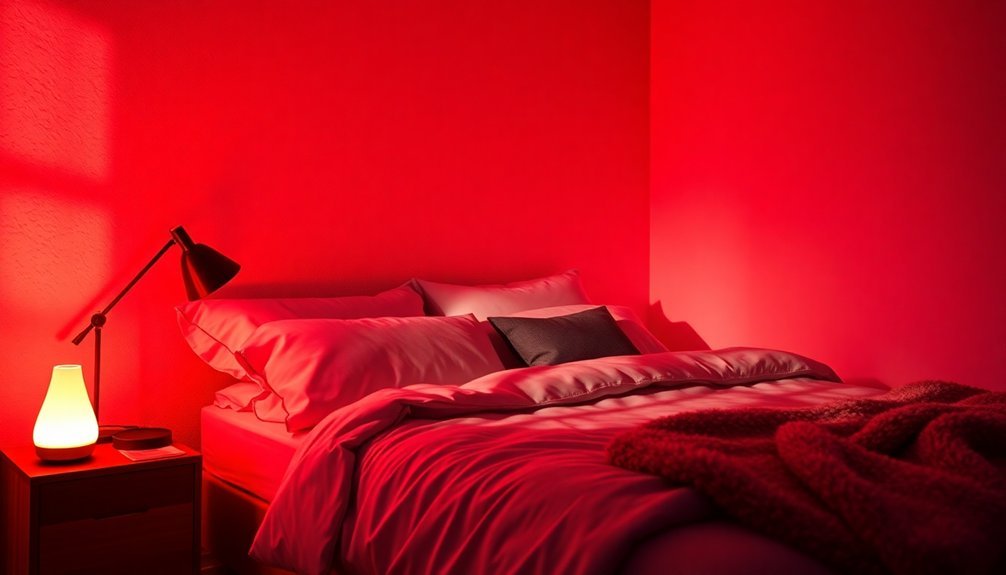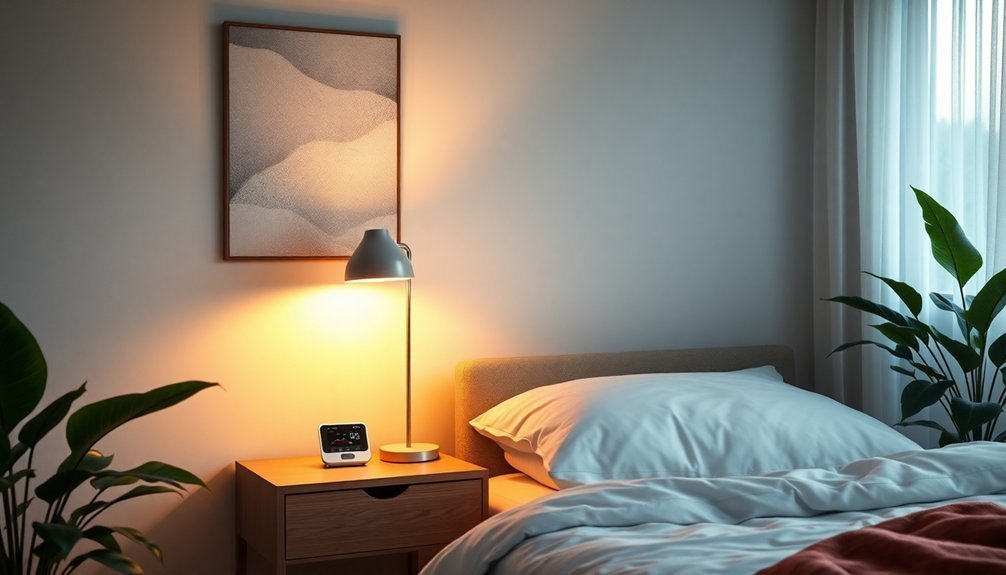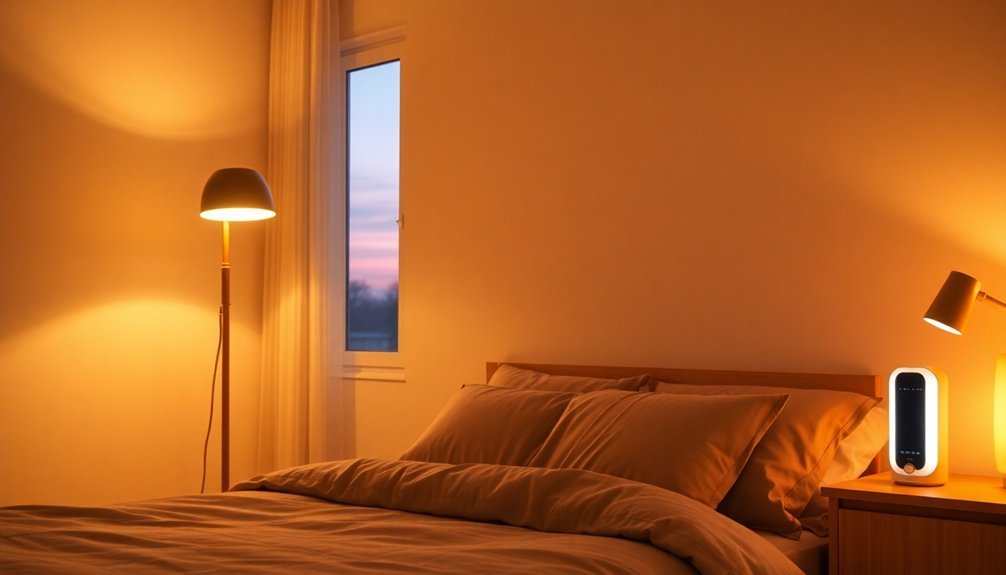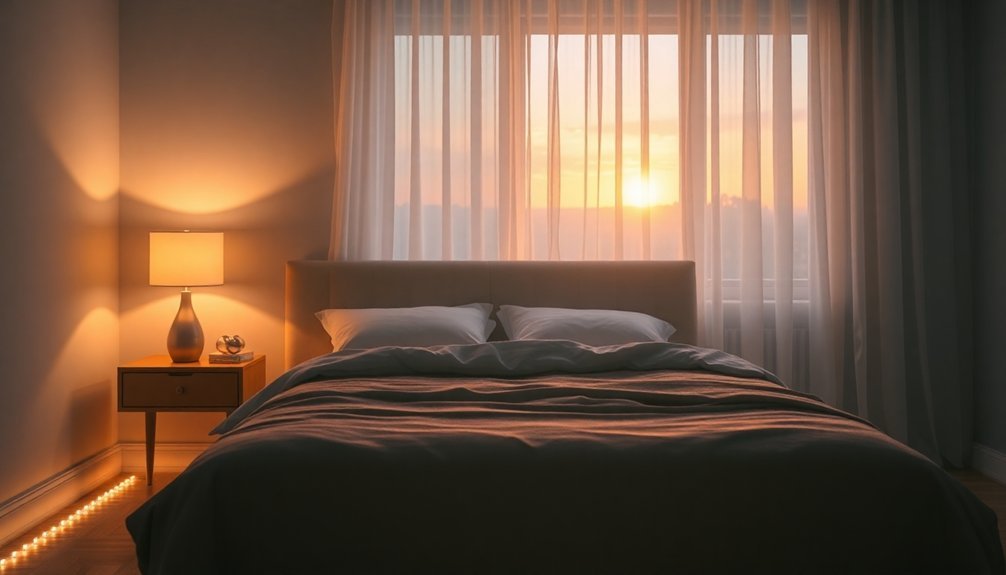To optimize your sleep quality, consider these five illumination treatments: red light therapy boosts melatonin production and enhances sleep duration, while infrared light helps regulate circadian rhythms and decreases sleep latency. Morning light therapy can reset your internal clock, using a light box with at least 10,000 lux for 20 to 40 minutes daily. Choose devices with suitable wavelengths, like 630 nanometers, that won't disrupt your sleep cycle. Finally, guarantee safety by avoiding direct eye exposure and consulting a doctor if you're on photosensitive medications. There's plenty more to discover about these therapies and how they can transform your sleep.
Benefits of Red Light Therapy

Red light therapy offers significant benefits for improving sleep quality, especially if you've struggled with sleep disorders like insomnia or sleep apnea.
Not only does this therapy enhance your sleep patterns, but it also supports the natural production of melatonin, the hormone essential for regulating your sleep-wake cycle. Unlike blue light, which disrupts melatonin levels, red light can actually increase serum melatonin, promoting a more restful night.
Research shows that it can improve sleep disturbance in various groups, including cancer survivors and professional athletes, providing relief from insomnia-related symptoms. Additionally, the mechanism of action involves stimulating the mitochondria, which boosts cellular energy and promotes healing.
If you deal with chronic pain, red light therapy can help alleviate discomfort caused by conditions like fibromyalgia or arthritis, ultimately making it easier for you to drift off.
You might find that you fall asleep quicker and wake up less frequently during the night, enhancing your overall sleep quality by an average of 34 minutes nightly.
With its analgesic properties and ability to reduce inflammation, red light therapy not only transforms your sleep experience but also addresses the underlying issues contributing to sleeplessness, offering a holistic path to better rest and rejuvenation.
How Infrared Light Works
Infrared light works by penetrating deeper into your body compared to visible red light, reaching cellular levels where it can effectively reduce inflammation and improve circulation. Harnessing the power of near-infrared (NIR) light, this therapy promotes tissue healing and provides pain relief, making it an ideal option for enhancing sleep quality. Unlike blue light, which suppresses melatonin production, NIR acts as a calming agent that helps regulate your internal clock and synchronize your circadian rhythms. Studies show that exposure to NIR light before bed can decrease sleep latency by around six minutes while improving average sleep quality and feelings of refreshment upon waking. Participants often report experiencing increased relaxation and a reduction in sleep inertia. In a recent clinical trial, those using the active NIR device experienced significant improvements in overall sleep and daytime function, highlighting its potential as an effective therapy for sleep complaints.
Clinical research supports these claims, demonstrating significant improvements in sleep and relaxation for those utilizing NIR light. To reap the benefits, you can incorporate NIR light therapy into your evening routine using wearable devices or red light therapy beds, preferably two to four hours before bed. Keeping the device's intensity lower can optimize relaxation and help prepare your body for a restful night's sleep.
Choosing the Right Light Device

When selecting a light device to enhance your sleep, it's crucial to take into account various options that cater to your specific needs. Red light therapy devices are a popular choice, as they emit pure red light at wavelengths like 630 nanometers, which can aid melatonin production. Studies show that warm hues like red light do not disrupt circadian rhythms and are ideal for nighttime use.
Some devices even incorporate near-infrared light for deeper therapeutic benefits, making them especially appealing if you're looking to improve sleep quality. Another option is ambient red light, which diffuses uniformly throughout your environment, mimicking natural twilight. This kind of lighting is effective in nightlights, reading lamps, and strip lights.
Just remember to avoid red-tinted incandescent bulbs, as they don't emit genuine red light. Key features to evaluate include the wavelength and intensity. Make sure the device you choose emits appropriate wavelengths that won't suppress melatonin. Look for options that gradually fade in intensity to mimic natural dusk, setting the atmosphere for relaxation. Additionally, reflect on safety; choose devices made from non-toxic materials, especially for children.
Scientific endorsements can also guide you toward safe and effective choices.
Recommended Treatment Protocols
How can you effectively integrate light therapy into your daily routine for better sleep quality?
Start by timing your sessions correctly. Aim for morning light therapy immediately after waking up, ideally between 6:00 a.m. and 9:00 a.m., to reset your circadian rhythm. If you have a delayed sleep phase, morning exposure will help you feel sleepy earlier. For those struggling with early awakenings, consider evening sessions to push your sleep cycle later.
Select a light box with an intensity of at least 10,000 lux and schedule 20 to 40 minutes of use each day. If using a lower-intensity device, plan for longer sessions.
Consistency in both the timing and duration of treatments is critical; try to maintain regular wake-up times, even on weekends, to stabilize your rhythm.
Combine light therapy with behavioral changes—create a dark bedroom at night, avoid screens before bed, and engage in relaxing activities. If you need to dim morning light, consider wearing blue light-blocking glasses.
Safety Tips for Light Therapy

Integrating light therapy into your routine can greatly enhance your sleep quality, but it's vital to prioritize safety while doing so. To get the most out of your sessions without compromising your health, follow these essential safety tips:
| Tip | Details | Action |
|---|---|---|
| Contraindications | Avoid if you have active cancer, are pregnant, or allergic to silicon. | Consult a healthcare provider. |
| Light Sensitivity | Test sensitivity first; never stare directly into the light. | Use provided glasses if needed. |
| Medications | Don't use if on photosensitive medications or have a history of seizures. | Check with your doctor before starting. |
| General Safety Measures | Guarantee comfort during treatment; supervise minors. | Avoid sharing the device for hygiene. |
Keep a watchful eye on how your body reacts, adjusting the duration or intensity if you experience discomfort. Maintain a clean and controlled environment during use and always shield your eyes. With these precautions, you can safely enjoy the many benefits of light therapy for your sleep quality.
Frequently Asked Questions
Can Light Therapy Help With Chronic Insomnia?
Yes, light therapy can help with chronic insomnia. You'll experience reduced wake after sleep onset, improved sleep quality, and better circadian regulation. Just make certain consistent timing and adequate light intensity for best results.
How Long Until I See Results From Light Therapy?
You'll notice results from light therapy within a few days, but it can take up to two weeks or longer. Consistency is key, so stick with your daily sessions for the best outcomes.
Are There Any Side Effects to Using Light Therapy?
Yes, light therapy can cause side effects like headaches, eye strain, and irritability. You might feel tired or experience sleeping problems, especially if used in the evening. Always consult a doctor for personalized advice.
Is Light Therapy Safe During Pregnancy?
Yes, light therapy's safe during pregnancy when used correctly. It's non-invasive, poses minimal risks, and has no significant adverse effects. Always consult your healthcare provider before starting, and monitor how your body responds.
Can I Use Light Therapy With Other Sleep Medications?
Yes, you can use light therapy with other sleep medications. Just guarantee you monitor your response carefully, as combinations may enhance effectiveness. Consulting your healthcare provider is advisable to optimize your treatment plan.
In Summary
Incorporating the right illumination treatments can greatly enhance your sleep quality. By understanding the benefits of red and infrared light, choosing the right devices, and following recommended protocols, you'll set yourself up for better rest. Always prioritize safety to guarantee a successful experience. With these strategies, you're well on your way to enjoying deeper, more restorative sleep. Embrace these techniques, and let them transform your nightly routine for the better. Sweet dreams await!





Leave a Reply